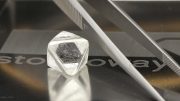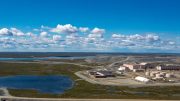It’s been nearly two years since Dominion Diamond (TSX: DDC; NYSE: DDC) picked up a majority interest in the Ekati diamond mine from BHP Billiton (NYSE: BHP; LSE: BLT) for around US$550 million, and the company has been consistently impressing with its efforts to improve operations at the mining complex ever since.
Following the acquisition, Dominion has been working to adjust the recovery circuits at Ekati’s plant, and the program has resulted in impressive financials. Carats recovered in the first six months of fiscal 2015 were estimated to be 30% ahead of plan, with rough diamond production pegged at 2 million tonnes grading 0.67 carat per tonne for around 1.4 million total carats recovered.
During the second quarter, Ekati recorded sales of US$170.3 million, with around 600,000 carats sold at an average price of US$308 per carat.
To achieve improved diamond recoveries, Dominion has applied greater discipline to the maintenance and operations of the high-pressure grinding roll (HPGR) within the process plant. As a result, less coarse feed is being pushed through to the heavy media separator (HMS) modules, which has had a positive impact on the overall liberation of diamonds from kimberlite plant feed.
“We’ve improved the heavy-media separation at the plant. Frankly, it was the opinion of our consultants that the heavy media being run at such a high rate, like it was previously, was actually resulting in the loss of diamonds,” noted chairman and CEO Robert Gannicott during a presentation at the Dundee Diamond Conference in Toronto in early October.
“That’s been consistent with our experience dealing with the re-process and reagents. With very little work over a short amount of time you can see that we’ve improved the operation well beyond what we thought we had purchased,” he said.
And Ekati continues to grow, with Dominion identifying an exploration target at its Misery South and Misery Southwest satellite pipes that it converted into inferred resources in mid-July. The new targets host around 3.9 million tonnes averaging 1.3 carats per tonne for 5 million contained carats. The company is incorporating Misery — which lies around 30 km from the Ekati camp — into its operation, with stripping under way and full-year production expected from an open pit by 2016.
“In my view, we bought Ekati because of a past, a present, and a future,” Gannicott continued. “I would say that the past is great because it is the result of staking a very large piece of ground with two very significant geological trends that have hosted nine extremely valuable diamond orebodies. There are another four in what I’d qualify the development stage, and another three in advanced evaluation. The other thing that came with it was a very well-built piece of infrastructure, with a processing plant that was built to be greatly expanded.”
In fact, Dominion notes that reserves and resources at Ekati will still not fully use its processing capacity of roughly 4.35 million tonnes per year. The company plans to use the spare capacity to process additional material from the Koala North underground and Misery Northeast pit, as well as coarse ore-reject stockpiles. It’s notable that none of this additional material is included in the current mine plan.
The stockpiles are another upside opportunity Dominion acquired that wasn’t viewed as a value-add proposition at the time of the BHP deal. Coarse ore has been stockpiled at Ekati since the start of production in 1998. These rejects are estimated to total up to 4.5 million tonnes. Based on stone size distributions and recovery data, this material has an overall grade ranging from 0.2 to 0.6 carat per tonne.
“Most diamond plants take anything of significant size that actually floats in the first dense-media separation back into the circuit and re-crush it to liberate more diamonds,” Gannicott explained. “In order to achieve maximum velocity, BHP opted to run these valuable orebodies through very quickly to ‘get the cream off the top,’ which means there are large quantities of coarse ore rejects that have proven to be very valuable feed stock. We didn’t expect that when we purchased the asset, but we’re very glad to have it.”
Jay project
Besides mill improvements, Dominion is focused on its Jay project, which Gannicott labels “the long-term future mine life of Ekati.” The company has invested around US$16 million at Jay this year, which involves the “development of the largest diamondiferous resource in North America.” Dominion figures that an open pit at Jay could extend Ekati’s life by 10 years beyond scheduled closure in 2019, with the potential for underground mining beyond that.
BHP had explored Jay’s development potential, but the major was hesitant since the deposit sat underneath a lake at depths of between 30 metres and 40 metres. Gannicott says those water depths present a “large-scale engineering challenge,” but Dominion has tailored a different strategy.
“The Jay pipe is large and the open pit will be slightly bigger than a kilometre in diameter,” he explained. “BHP assumed they’d be dealing with that water depth generally, but we realized that most of the lake is actually very shallow. So we proposed a different scenario with a longer dyke that’s only typically in water about four metres deep.”
The company intends to complete a developer’s assessment report (DAR) and a prefeasibility study for Jay by the end of November. The DAR submission is the next step in the environmental assessment process. Dominion expects to have a decision on it from the Northwest Territories government by the end of 2015.
On Oct. 15, Dominion announced it had further expanded its interest in Ekati through another deal with Chuck Fipke, which saw the company pick up an additional 8.9% interest in the Core zone and an additional 6.53% interest in the Buffer zone. The purchase price for the Core interest was US$55.4 million, while the price for the Buffer zone was around US$14.35 million. The deal gives Dominion an 88.89% interest in the Core zone and a 65.3% interest in the Buffer zone.
“One thing I’ll say about past exploration efforts is that they were very much geared towards finding things as quickly as possible,” Gannicott continued. “As such, they were predominantly confined to geophysical programs, which perhaps ignores the fact that the early discoveries were made on the basis of geochemical work. We’re doing some really serious exploration between Sable on the north end and the main clusters to the south.”
Dominion’s second production pillar is a 40% interest in the Diavik mine, managed by majority partner Rio Tinto (NYSE: RIO; LON: RIO), which has also benefited from recent operational improvements. The companies have focused on improving availabilities, removing plant bottlenecks and increasing utilization of equipment, which have contributed this year to a boost in tonnage processed and carats recovered.
Based on an updated mine plan, the partners expect to process 2.2 million tonnes of material and produce roughly 6.5 million carats at Diavik this year. Mining activities will be exclusively underground with around 700,000 tonnes expected to be sourced from the A-154 North pipe, around 500,000 tonnes from the A-154 South pipe and 800,000 tonnes from the A-418 pipe. Results of a prefeasibility study on the A-21 pipe are anticipated by the end of the year, which could offer further upside at Diavik.
BMO Capital Markets analyst Edward Sterck — who maintains a stock “outperform” rating on Dominion along with a $20 share price target — notes that to meet its production guidance for the year, Diavik would only need to produce 1.1 million carats in the fourth quarter, well below the year-to-date average quarterly production of 1.9 million carats. “As such, there is significant potential for Diavik to beat production guidance,” Sterck says.
In the second quarter, Dominion reported sales from Diavik of US$107 million, compared to US$91.3 million in the same period in 2013. Sales totalled around 1 million carats for an average price of US$112 per carat, which compares to 700,000 carats for an average price of US$130 per carat during the second quarter of 2013.
Dominion shares have traded within a 52-week range of $12.89 and $16.83, and closed at $16.24 per share at the time of writing. The company reported US$384 million in net cash at the end of July, and maintains 85 million shares outstanding.
— Matthew Keevil is a Vancouver-based staff writer with The Northern Miner.




Be the first to comment on "Dominion unearths plenty of upside at Ekati"